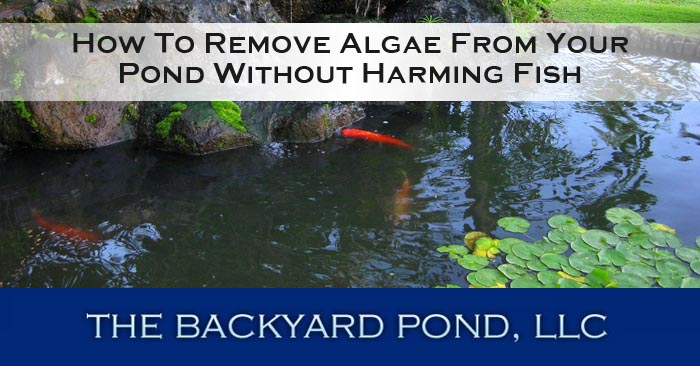
If you are searching “how to remove algae from my pond” or “how to clean algae from my pond without harming fish” this post should help send you in the right direction.
Algae or string algae is a filamentous species that attaches to plants, hangs from rocks in waterfalls, or hangs on the surface of the water. The long strands tangle together and form thick mats. Excessive string algae will reduce oxygen content, but it doesn’t mean bad water. New ponds often develop green water, but this usually clears within 90 days as plants grow and use up excess nutrients.
- Remove Algae
- Remove Debris
- Free Floating Aquatic Plants
- Use Barley Straw
- Utilize Beneficial Bacteria Tablets
1. Remove Algae
Rake out as much algae as possible with a pond or garden rake, taking care not to damage the pond liner by accidentally tearing it.
2. Remove Debris
Remove fallen leaves and dead plant foliage from the pond. Siphon plant debris and silt from the bottom of the pond with a pond vacuum, working slowly and carefully to avoid stressing your fish.
3. Free Floating Aquatic Plants
Plant enough floating aquatic plants so that around 50 to 70 percent of the pond surface itself is covered. Place free-floating plants directly into the water. Cover the soil in aquatic plant containers with heavy gravel and place them at the pond level that allows their foilage to float on the surface. If needed place bricks in the pond to stand container plants at the correct level.
4. Use Barley Straw
Place a bundle of barley straw on a large upside-down plastic pot in the pond, so that the bundle is just submerged underneath the water. One 8-ounce bundle treats around 1,000 gallons of pond water. The algae will slowly disappear as the barley straw breaks down when exposed to sunlight and oxygen.
5. Utilize Beneficial Bacteria Tablets
Place a tablet of beneficial pond bacteria in your pond, on a plant or rock, every two weeks. One 1-ounce tablet usually treats around 1,000 gallons of pond water.
Supplies You Will Need
- Aquatic Plants
- Beneficial Bacteria Tablets
- Bricks (Optional)
- Bundle Of Barley Straw
- Pond or Garden Rake
- Heavy Gravel
- Large Plastic Plant Pot
- Pond Vacuum
Tips For Your Pond
Anchored and also free-floating water plants shade out algae and can absorb excessive nutrients. Water lilies grow in water from 1 foot, up to 4 feet deep and can spread 5 to 6 feet wide. Bearing 5-inch summer flowers that open yellow and turn coppery-bronze, this low-maintenance plant is hardy. Fanwort which bears white flowers May through September and has branching stems of tiny, fan-shaped leaves spread 1 foot to 3 feet wide.
Warnings For Your Pond
Don’t oversupply your pond with fish. One hundred gallons of water is enough for one 6-inch fish or ten 1-inch fish. To determine the amount of water in your pond, multiply its average length, width and depth. Multiply the total by 7.5. This will give you the number of gallons in your pond.
Don’t over feed your fish. Give them as much as they can eat in two minutes, at least up to four times a day. Stop feeding as soon as food is left uneaten, and don’t feed your fish when temperatures are consistently below 45 degrees Fahrenheit.
The Backyard Pond Offers Pond Mainteance & Cleaning
We are specialists in imported Japanese Nishikigoi, Goldfish and Waterplants. We also offer Pond Supplies, Pond Construction and Design. All prices are subject to change without notice. Let us create the backyard pond of your dreams. Loaded with pleanty of koi fish, water gardens, aquatic plants and other pond accessories.